10 Sci-fi Films to Watch if you Liked Dune
Appreciating the Cinematography of Science-fiction

In his 2021 science fiction film Dune, Denis Villeneuve welcomes audiences to his version of the planet Arrakis—an inhospitable and sparsely populated desert wasteland. Set in the distant future amidst a feudal interstellar society, Dune is the first of a planned two-part adaptation of Frank Herbert's identically coined 1965 novel.
Considering his impressive filmography, a star-studded cast and the entrancing visuals garnered from the trailers alone, it is highly likely that we can prepare for what may be a potential classic in science-fiction cinema.
With Dune releasing in cinema’s this December in Australia, there are a great array of films audiences can watch to delve into the world of speculative fiction in preparation for the innovative cinematography of Villeneuve’s world.
Shaping Science-Fiction
A hallmark of science fiction cinema is the creation of new worlds. The appeal for audiences is being transported to alien, unknown spaces. Deeply rooted in cold, emotionally distant futures, cyberpunk aestheticism, or cutting-edge concepts like space exploration, time travel, the multiverse, and extra-terrestrial life, the visuals of these fictitious worlds are often embedded with a touch of nostalgia and world weariness. The genre of film as a mass medium for public consumption have disseminated cautionary parables of technological dystopia rooted in political, philosophical, economic, religious, and literary narratives of scientific progress.
Brimming with rumbling music, expressive colours, figures isolated in desolate landscapes... let’s examine the artistic choices underpinning some of the most visually stunning Sci-Fi’s of the cinematic universe.

We cannot talk about science-fiction without mentioning Ridley Scott's masterpiece the original Blade Runner (1982). An adaptation of Phillip K. Dick's work in its own right, the film is a vital piece of cinematic history, with its strong cyberpunk and aesthetic tones certainly aiding in its longevity.
Hailed for its production design depicting a decaying future, Blade Runner is a leading example of neo-noir cinema. The film is set in a dystopian future 2019 Los Angeles, in which replicants (i.e. synthetic humans) are bio-engineered by the powerful Tyrell Corporation to work on space colonies. A sense of foreboding pervades the ambience: the police seem omnipresent; vehicle and warning lights probe into decrepit buildings; corporate power looms large; and the philosophical consequences of huge biomedical mastery over humanity are explored. An oppressive backdrop, lit by a mesmerizing chiaroscuro cinematography, explains the frequently referenced migration of humans to "off-world" (extra-terrestrial) colonies. Visually breath-taking and full of some truly great technical marvels of filmmaking, Blade Runner is a film sci-fi fanatics will love.


Blade Runner: 2049 is an incredibly important film in many ways. Directed by Denis Villeneuve, it is a 2017 American neo-noir science fiction film that acts as both a reimagining and sequel of the Blade Runner world. The film is nothing short of marvellous, and offers a real testimony to the immersive nature of cinema. The stills will leave you consistently blown away by Roger Deakins immaculate cinematography: from its clear-cut symmetrical compositions, innovative architecture to the way the light reflects and fades into the angles of a room. The lighting is striking; ranging from the staple neon pinks and blues of the tech-noir genre to vibrant shades of yellows and inferno oranges.
The set design is simply beautiful. Scene layouts act as mounting fodder for intrigue—we see glass chambers filled with humanoid figures and housed in seemingly futuristic pyramids.
What's more, fans of Blade Runner 2049 will know that Dune could not be in safer hands as both pictures are directed by Villeneuve, whose visionary is on full display in 2049 reimagining, demonstrating that he can match the tone of the original and bring a number of novel ideas to the table.
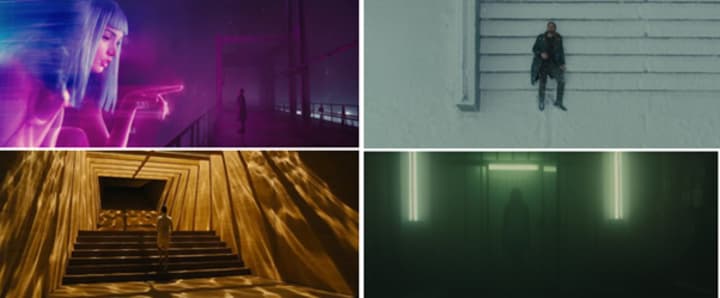
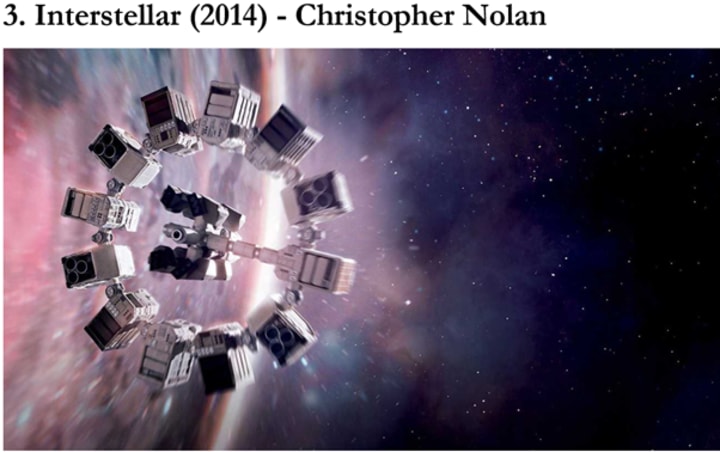
Interstellar is a 2014 epic science fiction film directed, co-written, and produced by Christopher Nolan. In 2067, dust storms and crop blights threaten humanity's survival. The only opportunity for humanity to find inhabitable refuge comes from an interstellar voyage utilising a wormhole near Saturn, that opens a path to a distant galaxy with 12 potentially habitable worlds.
The launch into space is utterly beguiling. We are led ricocheting through the wormhole’s scintillating plasmic vortex, as we transpire infinite celestial landscapes. The CGI is seamless. The space sequences were fantastic {and pay a true homage to Kubrick's 2001: A Space Odyssey}. Here, Christopher Nolan's cinema is characterized by actively developing all cinematographic channels: utilising outstanding sound elements {Hanz Zimmer's score is truly fantastic}, and visual vertigo in in filmic construction. Like Dune, Interstellar is a visually lavish and thematically dense science fiction that fans of Villeneuve are bound to enjoy.
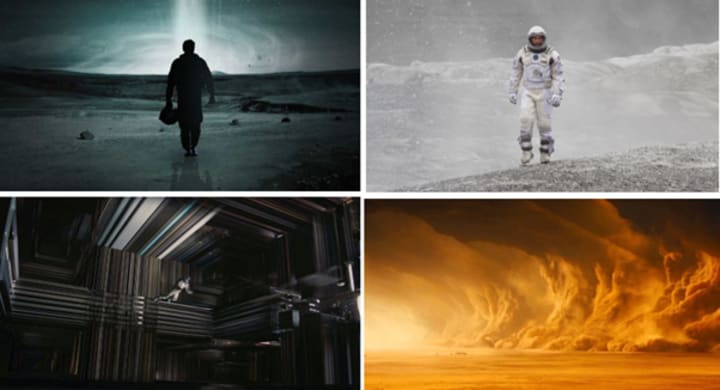
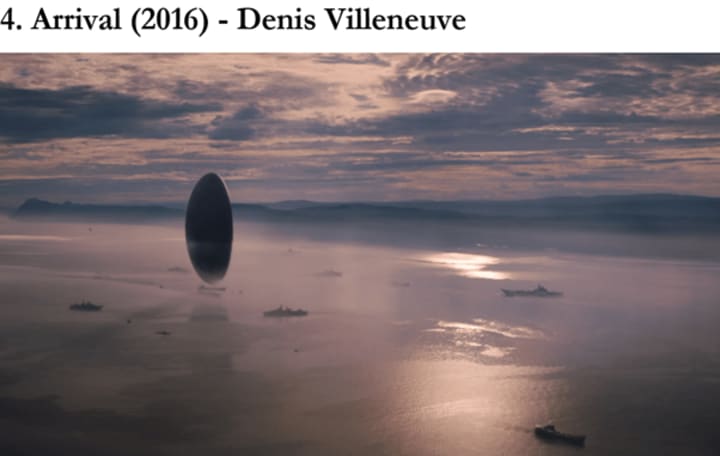
Arrival (2016) is another well-respected science fiction drama film directed by Denis Villeneuve. A modern classic of the sci‑fi genre, Villeneuve continually subverts expectations and shapes a theme fundamental to human existence into something even deeper.
The film begins with twelve extra-terrestrial spacecrafts floating above various locations around the globe. Disturbed nations send military and scientific experts to monitor and study them; among them is Banks, a renowned linguist, who makes first contact with two seven-limbed, cephalopod-like aliens (coined heptapods). Banks researches the complex written language of the aliens ( palindrome phrases written with circular symbols). When she asks why the aliens have come, they answer with a sentence which could be translated as "offer weapon".
The project Arrival demonstrates its originality in numerous ways; the thematics and use of time, the novel design of the alien guests, and the refreshing departure from the traditions of the genre. Slow paced, with incredibly sound design, and thriving with visual beauty, this film, once again, showcases a gem within Villeneuve's filmography.
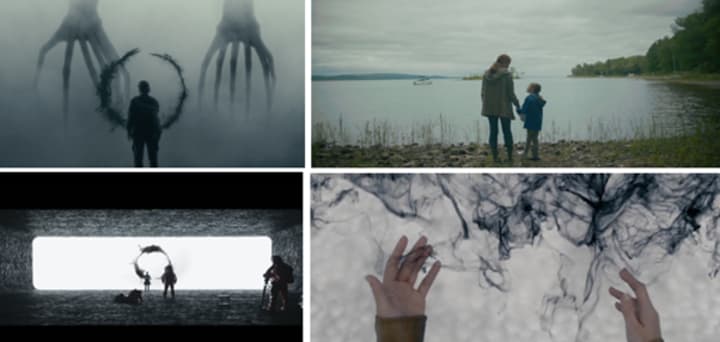

Based on the Japanese manga of the same name by Masamune Shirow, Ghost in the Shell is a 2017 science fiction action film directed by Rupert Sanders. It is set in the near future, in a world were humans are augmented with cybernetic improvements. Augmentation developer Hanka Robotics initiates a secret project to develop a cyborg "shell" (artificial body), that can integrate a human brain. The Major (Mira Killian)—the sole survivor of a cyberterrorist attack—is chosen as the test subject after her body is damaged beyond repair.
Ghost in the Shell is a visually faithful adaptation of Shirow's world with direct sequences inspired from the original film. While computer-generated images (CGI) is a tool that may be overused, here it presents a gorgeous overview of the city-scape. With ground-breaking special effects, stunning cinematography and a detailed transition between the real world and the digital space, the world of Ghost in the Shell is well realised. If your looking for a sci-fi film with ground-breaking visuals, Ghost in the Shell is for you.


2001: A Space Odyssey is a 1968 epic science fiction film produced and directed by Stanley Kubrick. The film is noted for its scientifically accurate depiction of space flight, pioneering special effects, and ambiguous imagery. Kubrick avoided conventional cinematic and narrative techniques; dialogue is used sparingly, and there are long sequences accompanied only by music. The experience is made a completely immersive one through the trade-off between subtle sounds heard onboard the vessel and then the cutaways to the haunting void.
2001: A Space Odyssey has been described as a space opera of sorts, divided into three separate acts. Each act is speculated to depict a various stages of humanities evolution. In the beginning, in a prehistoric veldt, a tribe of hominids learn about the use of tools and weaponry. The appearance of multiple Black Monoliths (machines built by an unknown species) acts as the catalyst in humanities technological advancement. The second Act propels us Millions of years later, where a spacecraft, with mission pilots and scientists, is bound for Jupiter. During their journey, they’re confronted with the potential dangers of HAL 9000 (their onboard, seemingly faultless supercomputer). HAL's ever-expanding intelligence ultimately threatens the next step in the evolutionary chain. The third act we have reached Jupiter, where a much larger monolith is orbiting the planet. Leaving the space vessel in an EVA pod, we are pulled into a vortex of coloured light and carried across vast distances of space, trespassing bizarre cosmological phenomena and strange landscapes of unusual colours.
The cinematography could be described as hypnotic. There are lengthy sequences without sound or dialogue, purposefully static images, bizarre planetary shots, and methodical frames that offer much to speculate and wonder upon in the silent depths of s p a c e ... Kubrick reduces each scene to its essence. He is not concerned with entertaining us, but with inspiring our awe. Indeed a revered film, 2001: a Space Odyssey offers a deeper allegory for all of humanity.


Based on the 2014 novel of the same name by Jeff Vander Meer, Annihilation is a 2018 science fiction psychological horror film written and directed by Alex Garland. The plot focuses on cellular biology professor and Army veteran Lena as she recounts her expedition to a zone called the "Shimmer," which emerged three years ago from the crash site of a meteorite that landed in the southern United States. The Shimmer is a brilliant, ephemeral translucent wall housing a number of beautifully bizarre occurrences: people disintegrate into a glowing fractal, hybrid animals roam and blossom-sprouting bodies occupy an open field by the number.
In Annihilation, Garland presents us with a mind-trip of amazing prosthetics, colourful cinematography, and dazzling visuals fashioned from a remix of existing creations. The way the films narrative filters cosmic mysteries through the lens of human psychological drama is reminiscent of Andrei Tarkovsky's Stalker (1979), with both focusing on the mirage of bizarrely-behaving water glasses to elude to broader transformations of the universe. Like Dune, the film pulls the audience in through awe-inspiring imagery, and its grand thought-provoking thematics.


Inception is a 2010 science fiction action film written and directed by Christopher Nolan. Set in a futuristic world where people are able to infiltrate their targets' subconscious and extract information through a shared dream world, Nolan makes the inner workings of the subconscious beautifully realistic in this film. Dreams are compounded out of the primal matter of the unconscious and the prosaic events of daily life. The constant interplay of dream and reality within the film feels uninterrupted. Slow motion effects are used to emphasize the revelation of the subjects’ dreaming; from café buildings exploding in Paris to buildings collapsing upon themselves, the film emphasizes the slowing of time in each subsequent dream.
The film offers minimal use of CGI from rotating corridors, and collapsing mansions artfully made with real effects. Inception, Christopher Nolan’s visually arresting, noir-tinged caper, is as packed with allusions and citations as a film studies term paper. With it's surreal visuals, arresting score and complex plot, Inception is a mind-bending trip worth taking.


Enders Game (2013) is a military science fiction action film based on Orson Scott Card's 1985 novel of the same name. Written and directed by Gavin Hood, it offers a well-regarded addition to the science fiction library that cinema continues to build. The story focuses on Ender Wiggin, an intelligent young, egotistical tactician and strategist, who is recruited by the International Military to lead the force defending Earth from a genocidal alien race bent on destroying the human populous.
The computer graphics and special effects are terrific and the final simulated battles on the Formic home planet feel like we are watching a cascade of computer-game imagery. While the film never truly lives up to its potential, nor reaches the depth and complexity offered by the book, the technical elements of Ender's Game are admittedly impressive. The sets are well designed, the shots are nicely composed, and the CGI is beautiful. While visually, there is ground-breaking imagination, all of this is placed in narrative that never truly finds itself. Regardless, Enders Game is still reminds us of the arresting cinematography science fiction cinema has to offer.


Ex Machina (2014) is a science fiction psychological thriller film written and directed by Alex Garland in his directorial debut. Starring Domhnall Gleeson, Alicia Vikander, and Dune's Duke himself, Oscar Isaac, the story combines inspiration from Mary Shelly's Frankenstein with fresh, thought-provoking moral dilemmas regarding AI and were technological infrastructure may be headed. Full of surprising twists, Ex Machina offers a cautionary parable of technological dystopia. The film has a precise visual sheen that evokes David Fincher, and earns the sudden, quiet, powerful scares of his best work. The merging special and practical effects makes for a grand visual spectacle that sci-fanatics will love.

About the Creator
Wonita Gallagher-Kruger
Hello,
I write Little Stories and Film Reviews. Please join me on my writing crusade. IG: wonita.gallagher.kruger







Comments
There are no comments for this story
Be the first to respond and start the conversation.